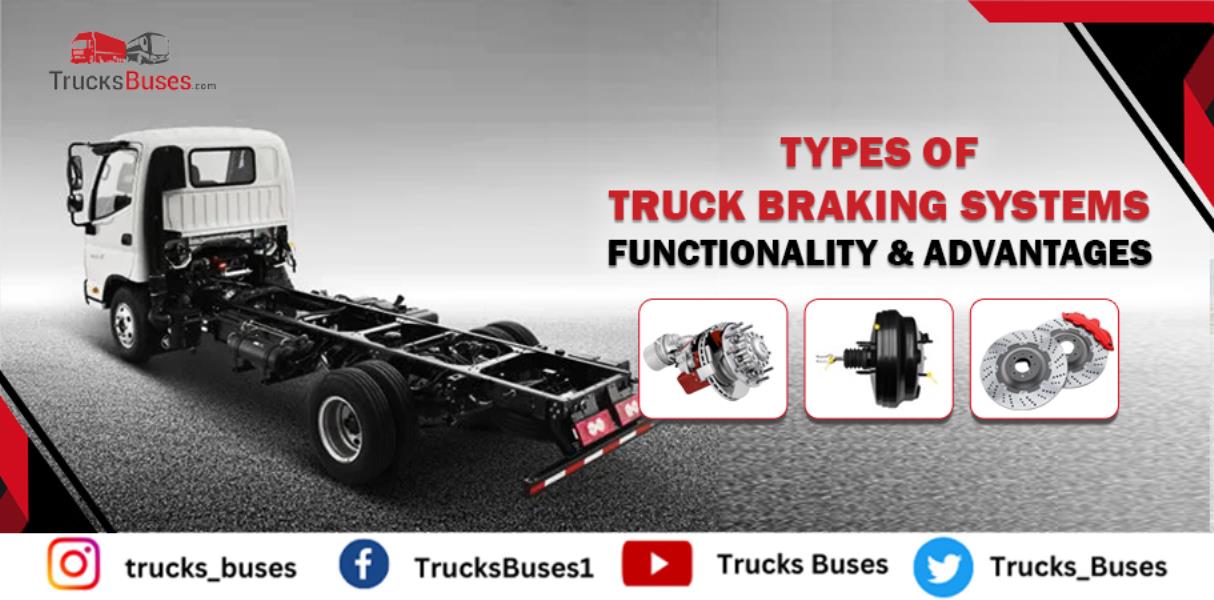Types of Truck Braking Systems - Functionality & Advantages
When it comes to trucks, safety is a top priority, and the braking system plays a crucial role in ensuring safe operation. There are several types of braking systems used in trucks, each with its functionality and purpose. Let’s explore these different braking systems and understand how they work.

Different Types of Truck Braking Systems and Their Functions
Air Brakes
Air brakes are the most common braking system in heavy trucks. They use compressed air to apply pressure to the brake pads. The system consists of an air compressor, air tanks, brake lines, and brake chambers.
- Functionality: When the driver presses the brake pedal, the air is released from the tanks and directed into the brake chambers. This air pressure pushes the brake pads against the brake drums, creating friction and slowing the truck down. Air brakes are highly effective for heavy loads and provide consistent braking power.
- Advantages: Air brakes offer strong stopping power and are reliable under heavy loads. They are also self-adjusting, which helps maintain optimal braking performance.
Hydraulic Brakes
Hydraulic brakes are commonly used in lighter trucks and passenger vehicles. They work by using brake fluid to transfer force from the brake pedal to the brake pads.
- Functionality: When the driver presses the brake pedal, brake fluid is pushed through the brake lines to the brake calipers. The fluid applies pressure to the brake pads, which then squeeze the brake discs or rotors to create friction. This friction slows the truck down.
- Advantages: Hydraulic brakes are smooth and provide good stopping power. They are also relatively easy to maintain and repair.
Disc Brakes
Disc brakes are often used in combination with other braking systems. They consist of a brake disc (rotor) and brake calipers. When the brakes are applied, the calipers squeeze the disc to create friction.
- Functionality: Disc brakes work by applying hydraulic pressure to the calipers, which press the brake pads against the spinning disc. This friction slows down the wheel and the truck.
- Advantages: Disc brakes provide strong and consistent braking performance. They are less prone to fading compared to drum brakes, especially under heavy use.
Drum Brakes
Drum brakes are another type of braking system commonly used in trucks. They consist of a drum that rotates with the wheel and brake shoes that press against the drum.
- Functionality: When the brakes are applied, the brake shoes are pushed outward against the inside of the rotating drum. This creates friction, which slows down the wheel and the truck.
- Advantages: Drum brakes are durable and can handle heavy loads. They are also cost-effective and provide reliable braking performance.
Engine Brakes
Engine brakes, also known as compression release brakes, use the truck’s engine to help slow down the vehicle. They work by releasing the engine’s compression pressure to reduce speed.
- Functionality: When activated, engine brakes close the engine’s intake valves and release the compressed air in the cylinders. This creates resistance and slows the engine down, which helps reduce the truck’s speed.
- Advantages: Engine brakes provide additional braking power without relying solely on the main braking system. They are useful for maintaining control and reducing wear on the primary brakes.
Conclusion
Understanding the different types of braking systems in trucks is essential for maintaining safety and performance. Each braking system, whether air brakes, hydraulic brakes, disc brakes, drum brakes, retarder brakes, or engine brakes, plays a unique role in ensuring the truck operates safely and efficiently. Regular maintenance and proper use of these braking systems help keep trucks in top condition and enhance overall safety on the road.
Read Also:
जानिये वाणिज्यिक वाहन बीमा से सम्बंधित पूरी जानकारी - सर्वश्रेष्ठ बीमाकर्ता
6 Key Benefits of Owning a Pickup Truck